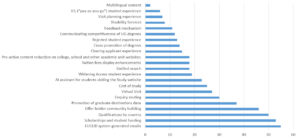Setting priorities for enhancements in 2026
Back in the summer, I surveyed the student recruitment and marketing community about the website and digital service improvements that would have greatest value for their work. The results of this survey have helped our steering group set priorities for the coming year.
While the team have been focused on delivering a totally transformed central website for prospective students and rolling out degree programme information for 2026, I’ve had my eye on what’s next.
Transforming our delivery
Our future state project may now be ended, but the future state we’ve delivered isn’t just about the new central website for prospective students. Or indeed, the new service and content management model we’ve rolled out for colleagues in schools, colleges and central services.
The future state project also sets us up for new ways of working on our new software platform. We have transformed our pipeline of future enhancements.
While we are undoubtably in a much stronger position, we still have much to do.
Our backlog (developer-speak for a to-do list) is still long. My rough estimate is that we have at least 5 years’ work ahead of us, based on what we have listed right now.
But we’ve removed barriers to delivery which means that future enhancements will keep coming and we’ll deliver faster.
How we developed our backlog
I started a rolling list of areas we still need to improve in late 2024, as we took stock of what we’d learned students and the business needed against what we’d been able to deliver through the future state project.
This list grew through insight and feedback including:
- Ongoing user research and usability testing with students which showed us where our provision was still coming up short
- Feedback from student recruitment and marketing colleagues who engaged in our workshops and collaborations
- Approaches from service managers – colleagues running services for prospective students who felt that improvements in their digital provision could save them time and effort
- Horizon scanning and competitor review which highlights broader trends in technology and user behaviour
The backlog is live list, so if you’ve got ideas for things you think we should be doing, get in touch with me. I’d love to learn more.
Neil Allison’s contact details
How we surveyed our community about the backlog
Back in the summer, I turned our backlog into a survey using the Top Task methodology pioneered by Gerry McGovern. (This is the same approach we’ve used to survey students about why they come to our website).
We presented the backlog of projects we could potentially do next, expressed as problems and opportunities for the business and/or prospective students.
My previous blog post inviting contributions from colleagues
Top task survey approach and how it works – a post by Pete Watson
The list was randomised for everyone who took part in the survey, and we simply asked colleagues to pick their top 5 priorities. We also asked them which part of the organisation they belonged to which meant that we learned how priorities differed across our three colleges and between colleges and support groups.
In total, 106 colleagues contributed which gave us a really good indicator of which enhancements would have greatest impact for the student recruitment and marketing colleagues we serve.

74% of responses came from colleagues in our three colleges, 26% from support groups.
Survey results

As is typical in top task surveys, a small number of items are identified as disproportionately important.
Three top priorities
Across all respondents, and in every college and support group sub-group bar one, the three most popular items when combined attracted around a third of all votes:
- EUCLID system-generated emails
- Scholarships and student funding
- Qualifications by country
Only colleagues in Science and Engineering opted for a different item in their top 3: Offer holder community building. Across all respondents, this was placed 4th.
The top three items (14% of options) attracted as many votes as the bottom 13 (60% of the options).
The top ten items attracted almost three quarters of the votes.

Across everyone surveyed, the top three items accounted for nearly one third of all votes, and the top 11 accounted for over three quarters.
Comparison across schools and support groups
The differences in priorities between schools and support groups, and between the three colleges are subtle. Given the relatively small response rate, the differences are not particularly worth analysing. Rather, it’s reassuring to note the consensus.
The top 3 items attracted between 31% and 40% of all votes, with the order of the top 3 differing.
It’s only below the top 7 (around 75% of all votes) that differences in priority begin to appear. And while there are differences, the margins are very small – around 1%.
Our focus for 2026
Our steering group met in early September, and considered the results of the survey as part of the discussion leading to their direction to the Prospective Student Web Team.
The group welcomed the insight from the survey, which helped them confidently feel they were representing the priorities of their college or support area.
The group agreed that we should proceed with planning and scheduling in these areas:
- EUCLID communications: How might we improve the content design of automated emails produced by the EUCLID application system?
- International qualifications: Integrate this content into individual degree profiles to reduce content management overhead and improve the website experience for international applicants.
- Enquiry management routing: We can improve the student enquiry experience and enhance our insight into where the website can work harder to support student self service, by redesigning the enquiry initiation process. We believe there are also opportunities to integrate AI into the experience to reduce the response time on enquiries needing human input.
- Cost of study content: We saw in our testing of the undergraduate 2026 release that while improved, student comprehension of the likely total cost of study still required further enhancement. We will continue to help students understand if study at Edinburgh is the right choice for them, and better meet our obligations to the Digital Markets, Competition and Consumers Act 2024.
- Clearing: Informed by the annual review of clearing, we believe there are opportunities to enhance student and staff experiences of clearing and to introduce better monitoring of service performance to inform a continuous improvement cycle in coming years.
- Offer holder community building: The University is considering a new approach using a dedicated platform to facilitate better engagement with students holding offers to study. The Prospective Student Web Team will provide user research, analytics and content management expertise to support student recruitment colleagues deliver a useful and usable user experience.
We also discussed digital services in the area of scholarships and student funding. While this was a top priority for student recruitment colleagues, and we know it’s also a critical consideration for prospective students, we had to acknowledge that the service area doesn’t currently have capacity to work with us. As such, this area will remain on the backlog to return to at a later date.
Timescales for delivery
These projects clearly can’t be delivered all at once. The Team is now embarking on early stage discovery work to map out the anticipated scope and timing of each project.
By meeting with stakeholders and collaborators, undertaking initial technical and content audits and reviewing existing research and analytics, we can better plan our capacity to deliver.
We undertake our projects in a very open and collaborative way. So it’s essential that subject matter experts and other stakeholders are available to work with us, and that delivery can dovetail with the needs of the annual student recruitment cycle.
I will make recommendations to our steering group in January, confirming the order and pace of delivery in these areas through 2026.
Questions?
If you’re a member of the University student recruitment, admissions and marketing community and want to ask or discuss anything around what the team is (and isn’t) doing in the coming year, I’d love to hear from you. Drop me an email.



